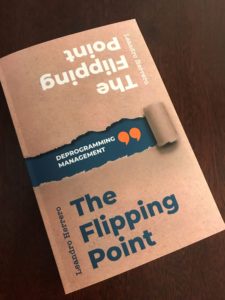Your linguistic and behavioural frame must be in sync. Story, values and behaviours need to be solid and well connected. Story, grammar and syntax must make sense when seen together.
You could have a good story, a good corporate narrative as an idea, perhaps a good differentiator (‘space in the world’) but your grammar stinks. Values are that grammar. Of course you have declared good ones, obvious ones, but what people see is not what is written. There is a disconnect. Your grammar is not good.
You could have a good story and good grammar, but the syntax fails you. For example, narrative and values have not been translated into behaviours, or this has been done badly. Most value systems that pretend to have a behavioural translation don’t have one. They have a sort of circular thinking in place, articulated in tons of words.
Integrity translated as ‘we will be honest and speak the truth, we will be genuine and authentic’ is an example. This is not a behavioural translation, it is a dictionary of synonymous in one line.
If you have trust as a value, for example, you must describe behaviours that generate trust, such as ‘keep promises’, instead of a rich semantic articulation of the 200 ways to explain trust with different words.
In my work as organizational architect at The Chalfont Project, we spend significant time on the behavioural side of things. This is an area of expertise that we cherish as a team.
In my experience, when those behavioural translations are done by copywriters or a creative agencies, very often they miss the point. Not that those words are not beautiful or attractive or motivating, but often they are not behaviours. Buying a Thesaurus dictionary would be much cheaper.
Behaviours must have an unequivocal meeting. There can be no possibility that three of you go home after a good debate and agreement ‘on behaviours’ with three different interpretations.
There is a school of (bad) thought in organizational development/HR/change management stuff, that says that people should be given a set of ‘values’ or ‘behaviours’ and then they should (democratically, I suppose) interpret them as they wish. This is very noble, if completely flawed thinking that opens all sorts of Pandora boxes and will take people into many different directions. By the way, the same people who promote this pseudo-democratic view of the organization, also want to have ‘one culture’. Yep, one culture of anything goes, that they will get.
Many missions/values/behaviours may have been established a long time ago. I do not suggest you review these frames every week, but it would be very healthy to check the story-grammar-syntax equation in case those synapsis of the organization’s nervous system are a bit rusty and the connections have become a bit weak.
______________________________________________________________________________________________
Our Feed Forward Webinar Series – the organization now, under new management continues on 16th July.
Register Here! Next webinar: The Myths of Company Culture on 16th July. Learn how to successfully mobilize your people for a purpose and change culture. Culture is the key to the complex post Covid-19 future in front of us.
To change to ‘the new normal’ we must think and act differently in the management of our organizations. Bring your critical thinking brain, switched on. It’s a serious business. It may also be fun.
Each participant who attends any of the live webinars of the Feed Forward series will be eligible for one copy of The Flipping Point.

________________________________________________________________________________________________
Don’t miss my new book: The Flipping Point – Deprogramming Management – available now!
 ____________________________________________________________________________________________
____________________________________________________________________________________________
Contact us to find out more about our speaking opportunities with Dr Leandro Herrero and his team.



Would you like to comment?